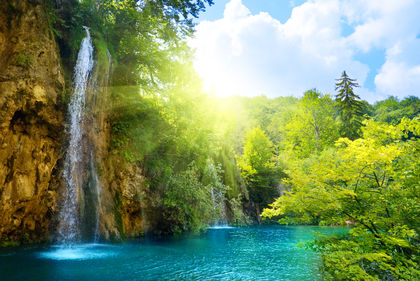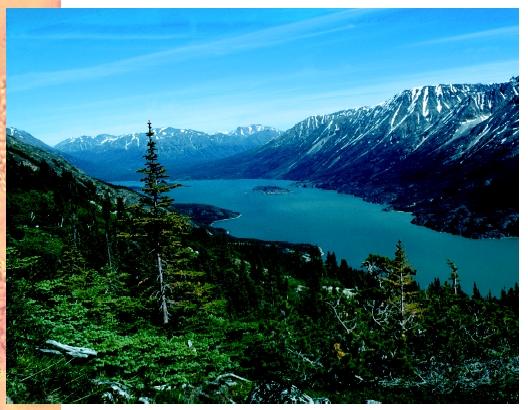Lakes and Ponds

Lakes and ponds are inland bodies of standing or slowly moving water. Although lakes and ponds cover only 2 percent of the world's land surface, they contain most of the world's fresh water. Individual lakes and ponds range in area from a few square meters to thousands of square kilometers. In general, ponds are smaller than lakes, though regional idiosyncrasies of naming abound—Henry David Thoreau's famous Walden Pond in Massachusetts has a surface area of 64 acres. Lakes and ponds are an important source of fresh water for human consumption and are inhabited by a diverse suite of organisms.
Formation
Lakes and ponds are formed through a variety of events, including glacial, tectonic, and volcanic activity. Most lakes and ponds form as a result of glacial processes. As a glacier retreats, it may leave behind an uneven surface containing hollows that fill with water. Glacial activity at the end of the Pleistocene epoch (ten thousand to twenty thousand years ago) resulted in the formation of most of the lakes and ponds in the Northern Hemisphere, including the Great Lakes of North America. Some of the oldest lakes and ponds (more than three hundred thousand years old) were formed by tectonic activity related to movement of Earth's crust. For example, Lake Baikal in Siberia formed from the movement of tectonic plates and is the largest freshwater lake by volume in the world. Volcanic activity can also lead to lake and pond formation. For example, the collapse of a volcanic cone of Mount Mazama in Oregon led to the formation of Crater Lake, the seventh deepest lake in the world.
Physical and Chemical Features
Light and temperature are two key physical features of lakes and ponds. Light from the sun is absorbed, scattered, and reflected as it passes through Earth's atmosphere, the water's surface, and the water. The quantity and quality of light reaching the surface of a lake or pond depends on a variety of factors, including time of day, season, latitude, and weather. The quality and quantity of light passing through lake or pond water is affected by properties of the water, including the amount of particulates (such as algae) and the concentration of dissolved compounds. (For example, dissolved organic carbon controls how far ultraviolet wavelengths of light penetrate into the water.)
Light and wind combine to affect water temperature in lakes and ponds. Most lakes undergo a process called thermal stratification, which creates three distinct zones of water temperature. In summer, the water in the shallowest layer (called the epilimnion) is warm, whereas the water in the deepest layer (called the hypolimnion) is cold. The middle layer, the metalimnion, is a region of rapid temperature change. In winter, the pattern of thermal stratification is reversed such that the epilimnion is colder than the hypolimnion. In many lakes, thermal stratification breaks down each fall and spring when rapidly changing air temperatures and wind cause mixing. However, not all lakes follow this general pattern. Some lakes mix only once a year and others mix continuously.

The chemistry of lakes and ponds is controlled by a combination of physical, geological, and biological processes. The key chemical characteristics of lakes and ponds are dissolved oxygen concentration, nutrient concentration, and pH . In lakes and ponds, sources of oxygen include diffusion at the water surface, mixing of oxygen-rich surface waters to deeper depths, and photosynthesis. Oxygen is lost from lakes and ponds during respiration by living organisms and because of chemical processes that bind oxygen. The two most important nutrients in lakes and ponds are nitrogen and phosphorus. The abundance of algae in most lakes and ponds is limited by phosphorus availability, whereas nitrogen and iron are the limiting nutrients in the ocean. The acidity of water, measured as pH, reflects the concentration of hydrogen ions . The pH value of most lakes and ponds falls between 4 and 9 (the pH value of distilled water is 7). Some aquatic organisms are adversely affected by low pH conditions caused by volcanic action, acid-releasing vegetation surrounding bog lakes, and acid rain.
Habitats and Diversity
Lakes and ponds are characterized by three main habitats: the pelagic zone, the littoral zone, and the benthic zone. The pelagic zone is the open water area of lakes and ponds. In large lakes, the pelagic zone makes up most of the lake's volume. The littoral zone is the inshore area where light penetrates to the bottom. This zone often contains large, rooted plants called macrophytes. The areas of the lake or pond bottom that are not part of the littoral zone are referred to as the benthic zone. This zone contains fine sediment that is free of plant life because light levels are too low to support plant growth.
Lakes and ponds typically contain a diversity of organisms that perform different ecological functions. Many of the organisms in lakes and ponds are quite small and can only be seen with a microscope. Plankton are microscopic aquatic organisms, including bacteria, algae, and zooplankton, that have little or no means of locomotion. In addition, there are many larger vertebrate animals that inhabit lakes and ponds, including fish and amphibians. Other organisms that use lakes and ponds for some activities include birds such as ducks, mammals such as beavers, and reptiles such as snakes.
Larger lakes can support as many as four or five different trophic levels, or groups of organisms that get energy in the same way. For instance, the major trophic levels in the pelagic zone, or open water areas, are phytoplankton , zooplankton, planktivorous (plankton-eating) fish, and piscivorous (fish-eating) fish. Microbes such as bacteria and protists are also important in lakes and ponds due to their role in decomposition and nutrient recycling. The food web in the pelagic zone is connected to the inshore food web because many mobile organisms from the pelagic zone (especially fish) use the inshore areas for shelter and food.
SEE ALSO Algae ; Ecosystem ; Estuaries ; Limnologist ; Rivers and Streams ; Wetlands
Janet M. Fischer and Katharine E. Yoder
Bibliography
Lampert, Winfried, and Ulrich Sommer. Limnoecology: The Ecology of Lakes and Streams. New York: Oxford University Press, 1997.
Moss, Brian. Ecology of Fresh Waters: Man and Medium. Oxford: Blackwell Scientific Publications, 1988.
Wetzel, Robert G. Limnology. Philadelphia, PA: W. B. Saunders Co., 1983.